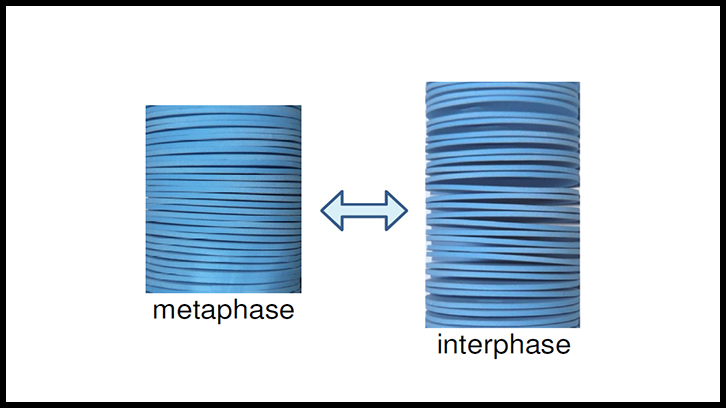Gene expression and DNA replication and repair in multilayered chromosomes

Chromosome condensation and cell division takes place during mitosis, which is the last phase of the cell cycle. Transcription occurs throughout all the stages (G1, S, and G2) of interphase and DNA replication occurs only during S phase. Knowing these three processes, early electron microscopy studies showed the emanation of chromatin fibers from mitotic chromosomes and interphase nuclei swollen with water without cations. Since then, most of the proposed chromosome models have a straightforward relationship with the linear geometry of the chromatin fibers. However, in the presence of cation concentrations corresponding to mitosis, studies of transmission electron microscopy, atomic force microscopy, and cryo-electron tomography, performed by researchers of the Laboratori de Cromatina del Departament de Bioquímica i Biologia Molecular from the UAB, showed that chromatin emanated from mitotic chromosomes is a planar structure that forms multilaminar plates composed of mononucleosome layers. These results led to the proposal the thin-plate model, in which it is considered that condensed mitotic chromosomes are formed by many chromatin layers stacked along the chromosome axis. Each layer contains approximately 0.5 Mb of DNA in human chromosomes. In buffers having interphase cation concentrations, the chromatin emanated from G1, S, and G2 nuclei also has a planar morphology, but the plates from interphase nuclei have a low tendency to form the multilayered structures observed in mitotic chromosomes.
In a perspective article recently published in FEBS Letters, it is suggested that during mitosis the tightly stacked chromatin layers inhibits transcription. In contrast, chromatin accessibility increases greatly when the layers become unstacked in interphase, and DNA is available for the interaction with the proteins of the transcription machinery from the two sides of the exposed chromatin layers.
Genome-wide chromosome conformation capture (Hi-C) studies have shown that in interphase there are many contacts between DNA sequences corresponding to topologically associated domains (TADs), which are considered to be the functional subunits of chromatin. Since the size of the TADs detected in Hi-C analyses of interphase cells is similar to the amount of DNA in a chromatin layer, it is proposed that each layer may correspond to a TAD. The loops of the chromatin filament proposed from the results obtained in Hi-C studies can be interpreted as contacts produced by the folding of the filament within layers. In particular, the enhancer-promoter loops required for gene expression could be pre-existent in the layers. During mitosis, TADs apparently disappear because the layers become closely stacked and consequently the contacts observed in Hi-C experiments involve more distant sequences in the genome.
According to previous studies, it is likely that planar chromatin within chromosomes forms a continuous helicoid. The absence of entanglements between the successive layers of this helicoid may facilitate DNA replication. Planar chromatin has to be locally disrupted to build active replication bubbles, and it is hypothesized that the complete replication of the original chromosome could yield an unentangled double-helicoid. This structure contains two copies of all the original DNA sequences in close proximity between them, which may facilitate repair of double-strand breaks by homologous recombination in any region of the genome. Furthermore, if double-strand breaks are produced, the network formed by planar chromatin can hold the two DNA ends in place, thus preventing chromosome translocations better than the loosely packed chromatin filaments typically considered in the current literature.
Finally, the separation of the two helicoids, by an unknown mechanism that presumably requires topoisomerase II, will produce two compact sister chromatids that can safely transfer the genomic DNA to the daughter cells.
Facultat de Biociències
Universitat Autònoma de Barcelona
References
JR. Daban. Supramolecular multilayer organization of chromosomes: possible functional roles of planar chromatin in gene expression and DNA replication and repair. FEBS Letters 594 (2020) 395-411. https://febs.onlinelibrary.wiley.com/doi/10.1002/1873-3468.13724


